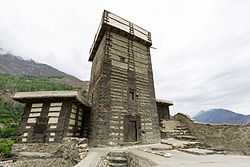Altit Fort
| Altit Fort | |
|---|---|
|
Main tower of Altit Fort | |
| Location | Altit, Gilgit-Baltistan |
| Built | 11th century |
| Restored | 2007 |
Altit Fort is an ancient fort at Altit town in the Hunza valley in Gilgit Baltistan, Pakistan. It was originally home to the hereditary rulers of the Hunza state who carried the title Mir, although they moved to the somewhat younger Baltit fort nearby three centuries later. Altit Fort and in particular the Shikari tower is around 1100 years old,[1] which makes it the oldest monument in the Gilgit–Baltistan.
History
The word Altit means this side down and is a Tibetan word. The people of Altit are said to belong to the white Huns, although not much research has gone into the matter. It is said that the present language Bruchiski was brought here by the white Huns in 47 A.D. The first name for Altit village was Hunukushal, meaning the village of Huns. The Huns came from the Huang-Ho valley in China. The name later changed to Broshal, translated as a village of Bruchiski speakers. They were spirit worshippers as Shamanism was in practice. In the 15th century Shia Islam was introduced. Around 1830 in turn many converted to Ismailism.
Restoration
The Altit Fort was in great disrepair, but has recently been restored by the Aga Khan Trust for Culture Historic Cities Support Programme and the Government of Norway. It is characterized by small rooms and low portals with exquisite wood carvings. Japan has contributed to the renovation of the surrounding old village. Altit Fort is a tourist site which has been open to the public since 2007.
See also
References
- ↑ "Cultural Heritage: UNESCO Award for Hunza fort". The Express Tribune. Retrieved 19 March 2013.
External links
| Wikimedia Commons has media related to Altit Fort, Hunza-Nagar, Hunza valley. |
Coordinates: 36°18′54″N 74°40′55″E / 36.315°N 74.6819°E
| ||||||||||||||
